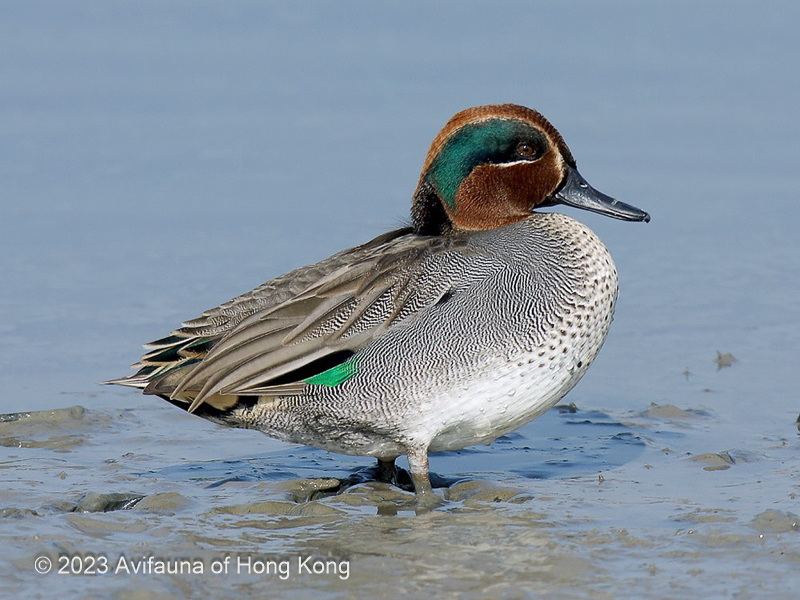Eurasian Teal Anas crecca 綠翅鴨
Category I. Abundant winter visitor to the Deep Bay area, though numbers are much lower than the 1990s.
IDENTIFICATION

Dec. 2007, Michelle and Peter Wong.
34-38 cm. The smallest duck in HK. Breeding plumage male has chestnut head with broad green patch extending back from the eye bordered by narrow orange-yellow line, grey sides to the body usually with a horizontal white line above, and black undertail coverts bordered by warm buff sides.

Oct. 2018, Michelle and Peter Wong.
Female has orange sides to the bill base, a rather plain face with a dark eye stripe and a broad pale line along the base of the tail. Eclipse male and juvenile similar to female.

Dec. 2005, John and Jemi Holmes.
Fast and agile in flight when it shows a short, broad white bar along the middle of the upperwing that is warm buff internally, and green inner secondaries with off-white tips to all of them.
VOCALISATIONS
The three calls most often heard in HK are associated with display activity in the winter. The male utters a high-pitched ‘pree’ or ‘preep’ that carries far and is easily recognised (similar to but higher in pitch than Northern Pintail). The other commonly heard call of the male is a chittering sound. The female utters a decrescendo call comprising a series of quacks decreasing in volume. All these calls can be heard in the following recording.
DISTRIBUTION & HABITAT PREFERENCE
Occurs in intertidal areas and brackish and freshwater marshes. Most records are from the Deep Bay area, particularly in Inner Deep Bay and Mai Po NR, but also including fish ponds and along river channels inland as far Kam Tin. Has occurred at scattered sites in the New Territories, especially in recent years at Long Valley where the highest count is 68. Elsewhere, the highest counts this century were in the Nam Chung and Luk Keng areas where up to 57 birds were present. Historically, at Tai Lam Chung Reservoir from 1966 to 1973 up to 400 birds were noted. The occurrence of such numbers of wildfowl on reservoirs in HK is exceptional, however.
OCCURRENCE
An abundant winter visitor, with the earliest arrivals often occurring in the first week of September, while departure has usually occurred by the middle of May. Figure 1 illustrates the pattern of occurrence from November to March as recorded by monthly waterbird counts since 1998.
Up to three birds have been recorded this century in the summer, while the highest count at this time is of five on 3 July 1982. Since 1999 only single figure counts have been made from 29 April to 9 September, while the earliest three figure counts are at the end of September and the earliest four figure count is in mid-December.
Figure 2 indicates that the number of Eurasian Teal recorded in winter waterbird counts since winter 2004/05 is lower than most previous counts, especially compared to the 1990s and early years of this century. The winter periods 1995/96 to 1999/2000 saw peak counts of no fewer than 3,500, with the peak for both the HK side of Deep Bay and the whole of Deep Bay being 5,411 on 24 January 1999. However, peak winter count on the HK side since 2004/05 has generally been 1,500 or fewer. This is lower than most previous winter waterbird counts since January 1979. When considering Deep Bay as a whole, the decrease is apparent only from winter 2009/10. Based on winter waterbird counts in Deep Bay Sung et al. (2021) concluded that the wintering population declined from 1998 to 2017.
Kershaw (1904) referred to Eurasian Teal as being ‘very common’; Dove and Goodhart (1913) stated it was ‘not uncommon’, sometimes occurring in large flocks, and that it had occurred from the end of August to the middle of April. Although Vaughan and Jones (1955) did not record the species, Herklots (1967) stated that it was ‘formerly undoubtedly the commonest duck...sometimes seen in flights of some hundreds of birds...[and was] quite common in the Deep Bay marshes.’
BEHAVIOUR, FORAGING & DIET
Forms large flocks especially when roosting. Rather tightly-knit flocks fly in a fast and rapidly turning manner. Pair-formation occurs here. Feeds by dabbling and upending, rarely diving.
RANGE & SYSTEMATICS
Monotypic. Breeds across much of the Palearctic between approximately 40°N and 70°N, apart from western Europe. Winters to the south in western and southern Europe, north, west and east Africa, parts of the Middle East and the Indian subcontinent to Indochina to Japan (Johnson et al. 2020). In China it breeds in northern Xinjiang and the far northeast, and winters from coastal areas of Jilin and the Bay of Bohai south to much of lowland China south of the Yellow River (Liu and Chen 2020).
CONSERVATION STATUS
IUCN: Least Concern. Population trend unknown.
Figure 1.

Figure 2.

Dove, R. S. and H. J. Goodhart (1955). Field observations from the Colony of Hong Kong. Ibis 97: 311-340.
Herklots, G. A. C. (1967). Hong Kong Birds (2nd ed.). South China Morning Post, Hong Kong.
Johnson, K., C. Carboneras, D. A. Christie, and G. M. Kirwan (2020). Green-winged Teal (Anas crecca), version 1.0. In Birds of the World (S. M. Billerman, Editor). Cornell Lab of Ornithology, Ithaca, NY, USA. https://doi.org/10.2173/bow.gnwtea.01
Kershaw. J. C. (1904). List of birds of the Quangtung Coast, China. Ibis 1904: 235-248.
Liu, Y. and Y. H. Chen (eds) (2020). The CNG Field Guide to the Birds of China (in Chinese). Hunan Science and Technology Publication House, Changsha.
Sung, Y. H., C. C. Pang, T. C. H. Li, P. P. Y. Wong and Y. T. Yu (2021). Ecological Correlates of 20-Year Population Trends of Wintering Waterbirds in Deep Bay, South China. Frontiers in Ecology and Evolution. Published 20 April 2021 doi: 10.3389/fevo.2021.658084
Vaughan, R. E. and K. H. Jones (1913). The birds of Hong Kong, Macao and the West River or Si Kiang in South-East China, with special reference to their nidification and seasonal movements. Ibis 1913: 17-76, 163-201, 351-384.

